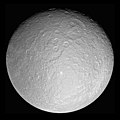Tiedosto:PIA07763 Rhea full globe5.jpg
Siirry navigaatioon
Siirry hakuun

Tämän esikatselun koko: 600 × 600 kuvapistettä. Muut resoluutiot: 240 × 240 kuvapistettä | 480 × 480 kuvapistettä | 768 × 768 kuvapistettä | 1 024 × 1 024 kuvapistettä | 2 048 × 2 048 kuvapistettä | 4 920 × 4 920 kuvapistettä.
Alkuperäinen tiedosto (4 920 × 4 920 kuvapistettä, 2,67 MiB, MIME-tyyppi: image/jpeg)
Tiedoston historia
Päiväystä napsauttamalla näet, millainen tiedosto oli kyseisellä hetkellä.
| Päiväys | Pienoiskuva | Koko | Käyttäjä | Kommentti | |
|---|---|---|---|---|---|
| nykyinen | 27. elokuuta 2018 kello 10.15 |  | 4 920 × 4 920 (2,67 MiB) | PlanetUser | Reverted to version as of 08:13, 13 March 2015 (UTC) |
| 15. elokuuta 2018 kello 13.09 |  | 4 920 × 4 920 (2,66 MiB) | The NMI User | Reverted to version as of 23:49, 14 August 2018 (UTC) | |
| 15. elokuuta 2018 kello 02.59 |  | 4 920 × 4 920 (2,64 MiB) | The NMI User | rv, fixed | |
| 15. elokuuta 2018 kello 02.49 |  | 4 920 × 4 920 (2,66 MiB) | The NMI User | Try making black | |
| 15. elokuuta 2018 kello 02.44 |  | 4 920 × 4 920 (2,65 MiB) | The NMI User | Fixed | |
| 13. elokuuta 2018 kello 11.09 |  | 4 920 × 4 920 (3,67 MiB) | The NMI User | Removing black borders | |
| 13. elokuuta 2018 kello 11.01 |  | 4 920 × 4 920 (2,67 MiB) | The NMI User | Reverted to version as of 08:13, 13 March 2015 (UTC) | |
| 13. elokuuta 2018 kello 10.56 |  | 4 920 × 4 920 (5,67 MiB) | The NMI User | Black background | |
| 13. maaliskuuta 2015 kello 11.13 |  | 4 920 × 4 920 (2,67 MiB) | MoreTomorrow | making square (to match other planet/moon images) | |
| 30. lokakuuta 2008 kello 09.43 |  | 4 920 × 4 820 (2,68 MiB) | WolfmanSF | This is the same full-resolution NASA image, with black panels added to the margins and some Photoshop processing to enhance contrast. |
Tiedoston käyttö
Seuraava sivu käyttää tätä tiedostoa:
Tiedoston järjestelmänlaajuinen käyttö
Seuraavat muut wikit käyttävät tätä tiedostoa:
- Käyttö kohteessa af.wikipedia.org
- Käyttö kohteessa ar.wikipedia.org
- قالب:المجموعة الشمسية
- قائمة أجرام المجموعة الشمسية مرتبة حسب الحجم
- قائمة أجرام النظام الشمسي المستديرة بالجاذبية
- قائمة الأقمار الطبيعية
- خط زمني لاكتشاف كواكب المجموعة الشمسية وأقمارها
- اكتشاف واستكشاف النظام الشمسي
- قائمة أنواع الكواكب
- بوابة:زحل/مقالة مختارة وصورة لأحد أقمار زحل
- قائمة أكبر الفوهات في المجموعة الشمسية
- 1981 ميداس
- Käyttö kohteessa ary.wikipedia.org
- Käyttö kohteessa arz.wikipedia.org
- Käyttö kohteessa ast.wikipedia.org
- Käyttö kohteessa as.wikipedia.org
- Käyttö kohteessa azb.wikipedia.org
- Käyttö kohteessa be.wikipedia.org
- Käyttö kohteessa bh.wikipedia.org
- Käyttö kohteessa ca.wikipedia.org
- Käyttö kohteessa ckb.wikipedia.org
- Käyttö kohteessa de.wikipedia.org
- Käyttö kohteessa el.wikipedia.org
- Käyttö kohteessa en.wikipedia.org
- Pioneer 11
- Rhea (moon)
- Cassini–Huygens
- Timeline of discovery of Solar System planets and their moons
- List of geological features on Rhea
- Naming of moons
- List of natural satellites
- List of gravitationally rounded objects of the Solar System
- Wikipedia:WikiProject Astronomy/Recognized content
- Portal:Solar System/Selected picture
- User:Dabomb87/Sandbox
- Tirawa (crater)
- Rings of Rhea
Näytä lisää tämän tiedoston järjestelmänlaajuista käyttöä.



